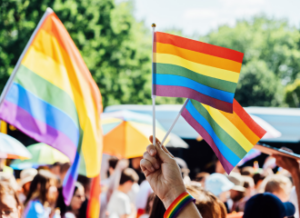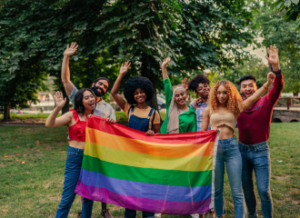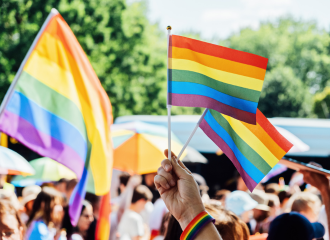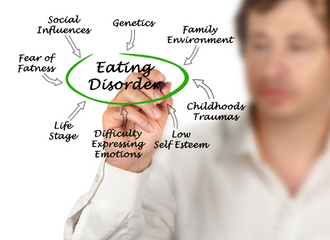Written By: Rebecca Chadwick, MS
Primary Therapist at The Renfrew Center of Radnor
 In comparison to heterosexual and cisgendered individuals, the LGBTQIA+ population is at an increased risk of developing eating disorders and other mental health issues [1]. Disordered eating patterns for LGBTQIA+ folks may develop for a variety of reasons, including managing or numbing painful emotions that arise in response to homophobia, transphobia, and gender dysphoria, as well as lack of access to culturally competent and inclusive mental and physical healthcare.
In comparison to heterosexual and cisgendered individuals, the LGBTQIA+ population is at an increased risk of developing eating disorders and other mental health issues [1]. Disordered eating patterns for LGBTQIA+ folks may develop for a variety of reasons, including managing or numbing painful emotions that arise in response to homophobia, transphobia, and gender dysphoria, as well as lack of access to culturally competent and inclusive mental and physical healthcare.
It’s important to know that eating disorders do not develop in just one population type or for one reason, including in the LGBTQIA+ community. Expanding our understanding of who is affected by eating disorders, including why someone developed this kind of coping mechanism, is key to providing a wide range of people with the tools needed for recovery. This article will provide an overview of the prevalence of eating disorders, co-occurring mental health issues, and unique risk factors in the LGBTQIA+ community, while also highlighting how you, as a support, can extend resources and care to someone struggling.
Eating Disorder Prevalence in LGBTQIA+ Populations
In general, LGBTQIA+ folks face a higher likelihood of experiencing body dissatisfaction, disordered eating patterns, and weight-based bullying and discrimination. According to The Trevor Project, 87% of LGBTQ youth reported dissatisfaction with their body in 2022 [2]. Other research has estimated that around 54% of LGBT youth have been diagnosed with an eating disorder while an additional 21% believed they likely had one at some point in their life [3]. Additionally, LGBTQIA+ people are more likely to consider suicide in their lifetime [4] and to experience depression and anxiety symptoms compared to their heterosexual counterparts [5].
LGBTQIA+ Eating Disorder Risk Factors & Reasons an Eating Disorder May Develop
LGBTQIA+ youth are at an increased risk of bullying, abuse, and feeling unsafe at school due to their sexual orientation and/or transgender identity [6]. LGBTQIA+ folks in general also report increased isolation from family and peers [7] and face a higher likelihood of being houseless, food insecure, and/or uninsured, creating various barriers to affirming medical care. Additionally, internalized homophobia, transphobia, and fatphobia can occur as a result of pervasive cultural prejudice, discrimination, and bullying, putting folks at elevated risk for eating disorders and disordered eating.
While cultural body ideals affect most portions of the general population, LGBTQIA+ folks may also want to manipulate their weight to feel more aligned with their true gender if they are experiencing gender dysphoria. For example, someone may want to stop the development of breasts, hips, a larger body frame, or muscle mass if this does not match their gender identity. LGBTQIA+ people may also turn to eating disorders in an attempt to manage the multiple marginalized identities they hold, essentially trying to reduce or prevent weight-based discrimination or stigma in addition to the homophobia and/or transphobia that they are likely already experiencing.
Finally, LGBTQIA+ individuals may learn early on in life to “mask”, “code-switch”, or otherwise conceal their gender and sexuality to prevent real and/or anticipated judgment and rejection from family, friends, peers, coworkers, etc. However, by hiding authentic parts of the self, LGBTQIA+ folks may also have a harder time asking for support or maintaining connection with their own identities, values, and emotional experiences, in general. At Renfrew, we understand that eating disorders not only serve as a way to avoid body image distress, but also general emotional pain that can stem from feeling unseen, misunderstood, or devalued by a stigmatizing environment. Some individuals, in addition to disordered eating, may try to numb or avoid emotions with substance use, self-harm, and suicidal ideation.
Support & Resources for LGBTQIA+ Individuals with Eating Disorders

Clinicians should normalize and make space for clients to share their chosen names and pronouns in sessions and assist them in finding community and/or building more supportive connections with others. Importantly, providers and support systems alike should remember that each person in the LGBTQIA+ community holds a unique story, set of identities, and goals for their mental health journey. Remaining curious, open-minded, and collaborative with the person you are supporting are reliable first steps in helping someone to heal.
Other supportive steps providers and loved ones can take:
- Respecting individuals’ decisions about coming out or not coming out in certain situations. Some people may be dependent on support systems, work environments, etc. that are not accepting of the LGBTQIA+ community. Clinicians should ask their LGBTQIA+ clients how they would like to be addressed in and out of session to ensure the clients’ safety, autonomy, and privacy.
- Providing environmental cues that LGBTQIA+ folks and topics are welcome. If a client has never shared their identities with someone before, it may be a big step to share it with a therapist, doctor, or even a loved one. Using your space to show that you are open to talking about and holding space for LGBTQIA+ identities and issues may give someone the courage needed to take that first step in talking about their experience.
- Allowing opportunities for individuals to experience gender fluidity and understanding that pronouns and expression of gender can change across time.
Other Resources for LGBTGIA+ Support
- Trans Lifeline: Trans Lifeline is a grassroots hotline and microgrants 501(c)(3) non-profit organization offering direct emotional and financial support to trans people in crisis – for the trans community, by the trans community.
- The Trevor Project: The Trevor Project is a nonprofit organization that provides crisis intervention and suicide prevention services to LGBTQ community.
- Pride Counseling: Pride Counseling provides a platform for the LGBTQ community to get the help they need affordably and conveniently.
- GLMA (Health Professionals Advancing LGBTQ Equality): GLMA is a national organization committed to ensuring health equity for lesbian, gay, bisexual, transgender, and queer (LGBTQ+) communities and equality for LGBTQ+ health professionals in their work and learning environments.
- GLSEN (Gay, Lesbian & Straight Education Network): GLSEN provides information and resources designed to help students take action to initiate changes in their schools and communities.
- True Colors United: True Colors United implements innovative solutions to youth homelessness that focus on the unique experiences of LGBTQ young people.
- It Gets Better Project: A non-profit designed to support and remind LGBTQIA+ youth that there is hope and it does get better, showcasing stories and reflections from people all over the world.
- PFLAG: PFLAG is the nation’s first and largest organization dedicated to supporting, educating, and advocating for LGBTQ+ people and those who love them.
- SAGE (Advocacy & Services for LGBTQ+ Elders): A national advocacy and services organization that’s been looking out for LGBTQ+ elders since 1978.
Therapist/Provider Directories
- Pride Counseling: Pride Counseling is an online therapy service featuring therapists who specialize in working with the LGBTQIA+ community.
- Inclusive Therapists: Inclusive Therapists offers a safer, simpler way to find a culturally responsive, LGBTQ+ affirming, social justice-oriented therapist.
- National Queer and Trans Therapists of Color Network: NQTTCN is a healing justice organization that works to transform mental health for queer and trans people of color.
- CDC LGBT Health Service Directory: A tool provided by the CDC to find health clinics, services, and networks in your state.
Renfrew’s SAGE (Sexuality and Gender Equality) Support Group
In this weekly virtual group, we provide a safe, nurturing, and empowering environment to enhance the eating disorder recovery experience, tailored for patients who are members of the LGBTQIA+ community.
References:
[1] Parker, L. L., & Harriger, J. A. (2020). Eating disorders and disordered eating behaviors in the LGBT population: a review of the literature. Journal of Eating Disorders, 8(1). https://doi.org/10.1186/s40337-020-00327-y [2] The Trevor Project. (2022, February 17). Eating Disorders among LGBTQ Youth. The Trevor Project. https://www.thetrevorproject.org/research-briefs/eating-disorders-among-lgbtq-youth-feb-2022/ [3] Parker, L. L., & Harriger, J. A. (2020). Eating disorders and disordered eating behaviors in the LGBT population: a review of the literature. Journal of Eating Disorders, 8(1). https://doi.org/10.1186/s40337-020-00327-y [4] National LGBT Health Education Center. (2018). Suicide Risk and Prevention for LGBTQ People. https://www.lgbtqiahealtheducation.org/wp-content/uploads/2018/10/Suicide-Risk-and-Prevention-for-LGBTQ-Patients-Brief.pdf [5] Marlay, M., File, T., & Scherer, Z. (2022, December 14). Mental Health Struggles Higher among LGBT Adults than Non-LGBT Adults in All Age Groups. Census.gov; United States Census Bureau. https://www.census.gov/library/stories/2022/12/lgbt-adults-report-anxiety-depression-at-all-ages.html [6] (n.d.). 2023 U.S. National Survey on the Mental Health of LGBTQ Young People. The Trevor Project. Retrieved April 15, 2024, from https://www.thetrevorproject.org/survey-2023/ [7] Karim, S., Choukas-Bradley, S., Radovic, A., Roberts, S. R., Maheux, A. J., & Escobar-Viera, C. G. (2022). Support over Social Media among Socially Isolated Sexual and Gender Minority Youth in Rural U.S. during the COVID-19 Pandemic: Opportunities for Intervention Research. International Journal of Environmental Research and Public Health, 19(23), 15611. https://doi.org/10.3390/ijerph192315611 [8] National LGBT Health Education Center. (2018). Suicide Risk and Prevention for LGBTQ People. https://www.lgbtqiahealtheducation.org/wp-content/uploads/2018/10/Suicide-Risk-and-Prevention-for-LGBTQ-Patients-Brief.pdf


